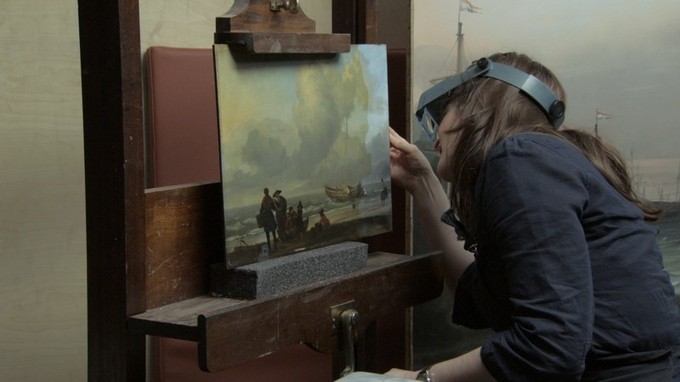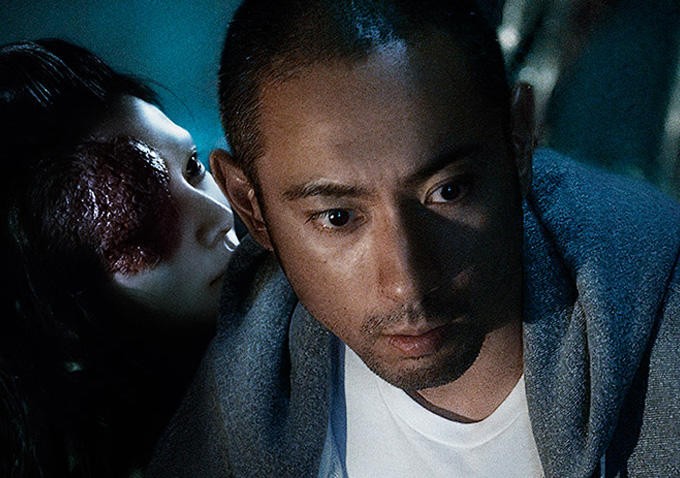
NATIONAL GALLERY (2014, directed by Frederick Wiseman)
An excellent addition to the lengthy Wiseman canon, NATIONAL GALLERY is a behind-the scenes exploration of one of the world's most important museums. Filmed during the gallery's late 2011 Leonardo da Vinci exhibition, Wiseman's dispassionate, omnipresent camera catches the rhythms and sometimes the rhymes (in the case of a woman reading a rather astounding poem inspired by Titian's Diana and Callisto, reflecting on Callisto's afterlife as a constellation that begins and ends with the line STAR STAR STAR STAR STAR...) of the staff, visitors and day-to-day routines of the institution.
If you've seen a Wiseman film before, you know what to expect. His hard-core observational style offers no traditional narratives or arcs, instead capturing discreet scenes and moments that paint a vivid picture of his subjects. Rather than capital-s Story, what ties a Wiseman film together is the physical space in which he's shooting. In 2010's BOXING GYM, for instance, the bounds of the film are defined by the tight confines in which the boxers are training, and that compact sense of space helps channel and propel the staccato thump of fists against a speed bag. In NATIONAL GALLERY the space is more open and more expansive, but at the same time it almost feels more constrained, as the limitations inherent in the environment allows for few big, emphatic movements – a sharp contrast from BOXING GYM, or LA DANSE, or CRAZY HORSE, Wiseman films in which the physical movements of his subjects within their workspace are everything. Individuals and groups in the gallery stay rooted, studying and discussing a specific work of art such as Rubens' Samson and Delilah (a recurring favorite in the film), or Turner's The Fighting Temeraire (there's a subtly hilarious scene in which a grumpy art critic is being filmed, presumably for a TV program, and after some prodding from his producer to say something about the metaphoric content of the painting he manages to say almost nothing beyond 'look at Turner's use of space and color' while using an awful lot of big words to do so.) A framer lays small sections of gold leaf in smooth, practiced motions on a newly-carved piece of wood. A curator compares barely perceptible changes in lighting for a specific display. Wiseman's subjects here aren't static, but their words and their actions are quiet and careful. When a workman starts ripping apart a facade to prepare an empty room for the next exhibition, it almost comes as a shock, and the film's one nerve-wracking moment comes when a pair of ballet dancers, performing as part of an installation, seems to come perilously close to smacking into the painting behind them.
What comes through is a sense of an institution that tries to stand apart from the passage of time, to be neither modern nor retrogressive but removed from that temporal equation entirely. Restorers discuss the importance of not repeating the errors of their predecessors, and how every act of restoration they undertake must be capable of being undone if it proves to be a mis-step. The art on display may be eternal, but its caretakers are ephemeral, working simply to ensure that future generations get the same chances to experience its beauty that they've enjoyed. There's something almost noble, and at least in the eyes of this colonial intrinsically British, in that reserved approach.
As always Wiseman's choices, both in camera and in the editing suite, are inspired. As onlookers study a particular painting, the juxtaposition of their words and the visual elements of the work that they discuss form a conversation of their own. The director understands, as well as the curators he's filming, that great works of art are more than capable of speaking for themselves, and his quiet technique never drowns out their voices.

OVER YOUR DEAD BODY (2014, directed by Takashi Miike)
The kabuki play Yotsuya Kaidan is one of the most influential pieces of theatre in history. The story of an amoral ronin whose murderous ways are only stopped when he's driven mad by the vengeful ghost of his wife, it's been adapted for film dozens of times over the last century, has developed a reputation for being as dangerous to perform on stage as MacBeth, and the iconic image of Iwa's ghost, with her long dark hair and deformed features, is essentially the ur-J-horror monster.
Miike's latest film, OVER HER DEAD BODY, isn't directly a filmed adaption of the play, however. Instead Miike gets his meta on, telling the story of the rehearsals for a new production of Yotsuya Kaidan and paying more attention to the tangled relationships and weird happenings off stage than on it. Miyuki, the veteran actress playing Iwa, is in a relationship with Kosuke, the young actor playing the ronin Iemon. On the side, he starts having an affair with the young actress playing the rich girl Iemon throws Iwa over for. Other members of the troupe also mirror their character's actions off stage – for instance, the married actor playing the blind masseuse who lusts after Iwa keeps hitting on Miyuki despite her rejections. Once the affair begins though, the mirroring becomes something more sinister and Miike takes the film into Audition territory, effortlessly juggling moments of exquisite dread with sequences of oh-god-did-that-just-happen genuine horror, including one that... no, no spoilers. Let's just say that some things shouldn't be DIY, particularly with kitchen utensils.
Like 13 ASSASSINS, OVER YOUR DEAD BODY feels constructed out of two distinct halves, but while the former has an agonizingly methodical build that explodes into crazy flaming-bull action in the finale, OYDB maintains a creepy atmosphere and seemingly inexorable pace right from the get go. Everyday objects are imbued with a sense of dread, and silences are charged with hidden menace. Gradually however, that implicit dread and menace becomes explicit. Dolls start crying. A wound on Miyuki's forehead gets transferred to her young rival's through the force of her rage. And, like his character Iemon in the play's final scenes, Kosuke begins experiencing horrific hallucinations (or are they?)
Special kudos has to go to art directors Yuji Hayashida, who's been working with Miike since CROWS ZERO, and Eri Sakushima, who joined the team a couple of years ago. The play within the movie takes place on a revolving platform, and each individual set looks outstanding, particularly the rich girl's family castle with its omnipresent centipede motif. The whole production of Yotsuya Kaidan is a superb, stylish blend of traditional and modern theatre, owing as much to innovators like Robert LePage as classic kabuki. The 'real' world of the actor's lives doesn't suffer by comparison either. Miyuki's apartment is a beautiful, austere echo of her apparent indifference to those around her, and as the paranoia and chaos escalates even the construction site the actors drive past on the way to the rehearsal studio seems to have evil intentions.
Simultaneously a stunning adaptation and a gruesome reinterpretation of a classic play, Over Your Dead Body is further evidence that Miike is at the peak of his powers, and that his frenetic, extensive filmmaking history has prepared him to tackle just about anything.
